Slave to the Game
Online Gaming Community
ALL WORLD WARS
PHOTO INTERPRETER'S GUIDE TO JAPANESE MILITARY INSTALLATIONS
1945.
PART III.
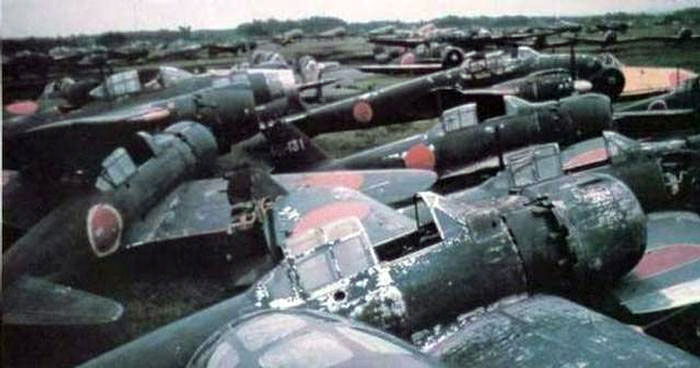
MILITARY INTELLIGENCE DIVISION
1 SEPTEMBER 1945
WAR DEPARTMENT
WASHINGTON, D.C.
SECTION XIII. COAST DEFENSE ARTILLERY
A considerable variety of coast defense guns have been mounted in Japanese installations encountered to date. Most of these have been naval guns, which in many cases have been removed along with their turrets and mountings from the decks of warships and placed in shore positions. Others have been guns of naval design, adapted for coast defense use. The Japanese have also used a considerable number of British weapons, and field artillery has been used for emergency coast defense. Dual-purpose batteries have played an important part in the Japanese coast defense system. The number of guns in a Japanese coast defense battery is not fixed.
76.2-MM NAVAL GUN
This is a naval gun originally purchased from the British and copied with Japanese variations.

Characteristics
Length of tube ... 10 feet
Maximum range ... 8,700 yards
Traverse ... 360 degrees
Elevation .. -6 to +20 degrees
Battery layout ... One-to three-gun batteries.
Revetments ... Usually square covered emplacements.
Fire control ... No external fire control equipment. Firing is done by direct laying.
Mount—Fixed pedestal.
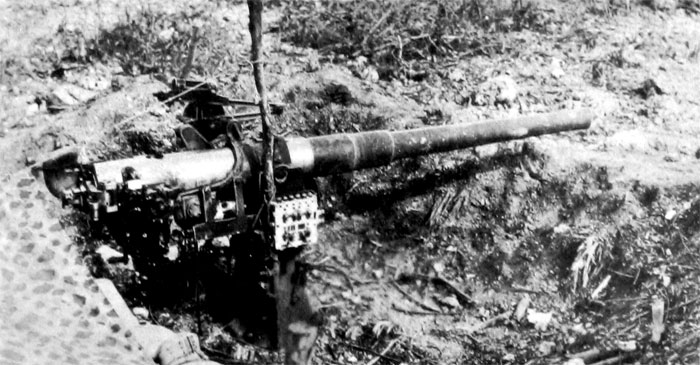
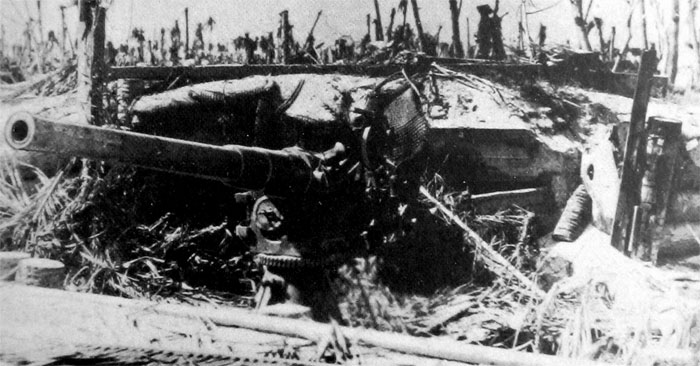
76.2-mm naval guns in coast defense positions captured by the Marines at Tarawa.
TYPE 3 (1914) 120-MM NAVAL GUN
This naval-type gun is found ashore with or without the shield. The recoil mechanism above the tube is similar in appearance to that of the Type 10 dual-purpose gun of the same caliber.
Characteristics
Length of tube .... 17 feet 6 inches
Maximum range ... 16,500 yards
Traverse ... 360 degrees
Elevation ... —5 to +55 degrees
Battery layout ... One- to four-gun batteries, usually in a straight line along the shore
Revetments ... 20 to 25 feet inner diameter.
Fire control ... No external fire control equipment has been found with captured batteries. However, a 2-meter base range finder may be used. Firing was conducted in the batteries captured to date by direct sighting combined with range scales.
Mount ... Pedestal.
Shield ... Approximately 8 by 13 feet, often removed.

Type 3 120-mm gun on Los Negros.
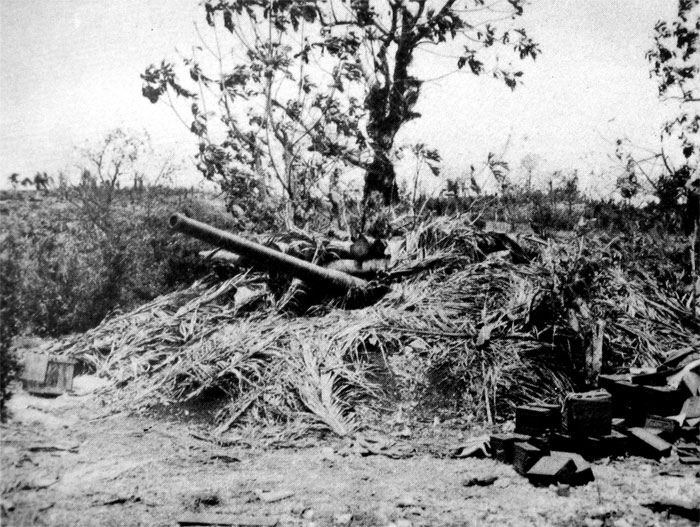
120-mm gun in position on Guam.
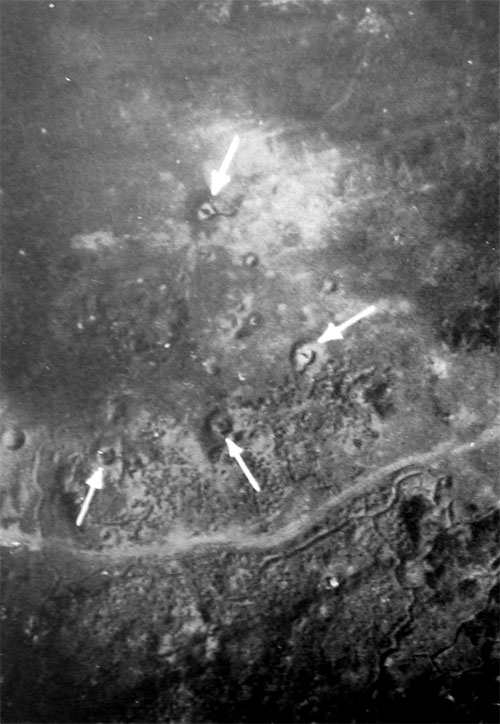
Scale 1:6,750, Iwo Jima, 120-mm dual-purpose battery.

120mm gun on Baanga liland, Solomons.

120 mm Qun capturtd on Lot Negros, Admlralty Group,

Four-gun 120-mm battery with shields on Wake lsland.
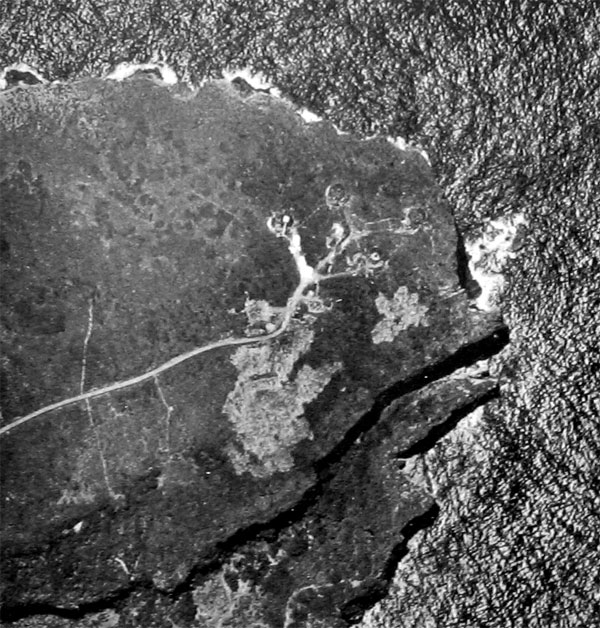
Scale 1:10,000. 120-mm battery on Saipan,

Oblique of Saipan 120-mm battery.
120-MM 40-CAUBER NAVAL GUN
Four of these guns were captured at Kiska, one of which is shown in the photograph above. Two were made by Armstrong-Whitworth and two were Japanese copies.
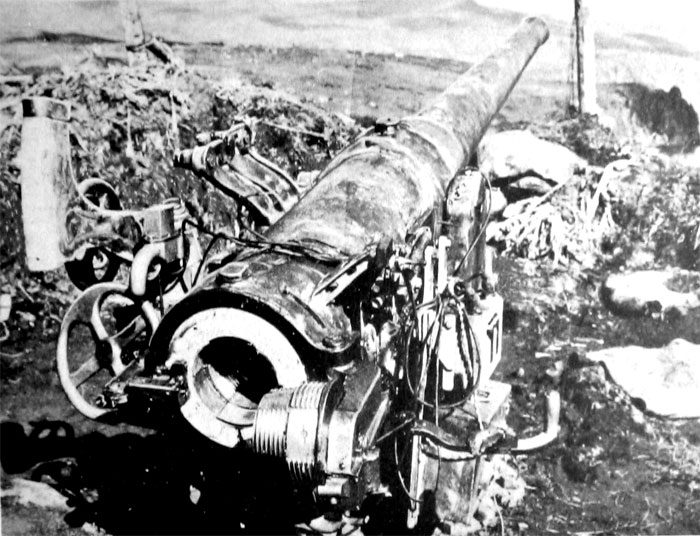
Characteristics
Length of barrel (including
breech mechanism) . . . . 16 feet 6 inches
Revetments ... Approximately 20 feet inner diameter
Fire control ... 2-meter base range finder, plotting room, and binoculars
Mount ... Pedestal, set in concrete.
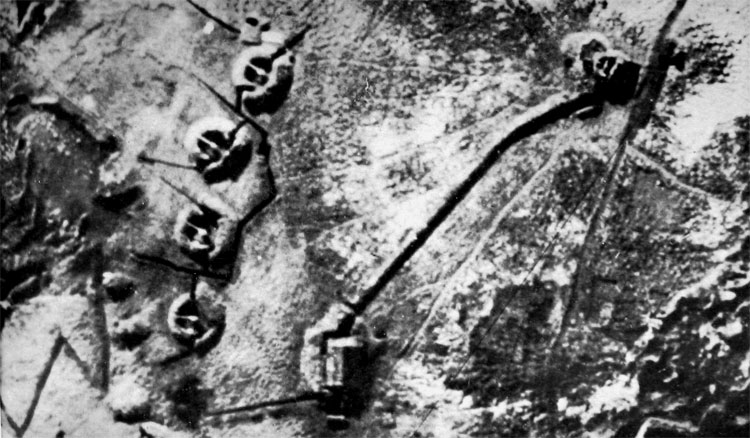
Scale
1:675 (approximately). A four-gun 120-mm 40-caliber battery with ronge
finder and learchtights.
TYPE 3 (1914) 140-MM NAVAL GUN
This naval-type gun has been found both with a deck-type shield and mounted in a hand-operated naval casemate shield. It is the most common coast defense gun used by the Japanese. When emplaccd ashore the shield is often removed.
Characteristics
Length of tube ... 22 feet 11 inches
Length including shield ... 24 feet
Maximum range ... 18,700 yards
Elevation ... —7 to +30 degrees
Traverse ... 360 degrees
Battery layout ... Two- and three-gun batteries. A tower is usually present for observation.
Revetments ... 34 to 37 feet inner diameter. Sometimes concrete construction is used. Revetments are not always used.
Fire control ... Binoculars and a 2-meter base range finder are often mounted on the observation tower.
Mount ... Fixed pedestal with a large spade buried beneath it when concrete is used.
Shield ... Deck type, almost square with the front corners rounded. Breech does not project beyond the shield. There is a prominent bump on the top of the shield at the left and two windows in the front. Dimensions: 7 feet 2.5 inches by 9 feet 4 inches.

Type 3 140-mm gun empfaced for coast defense at Tarawa, Note bump on top of shield and windows in the front.
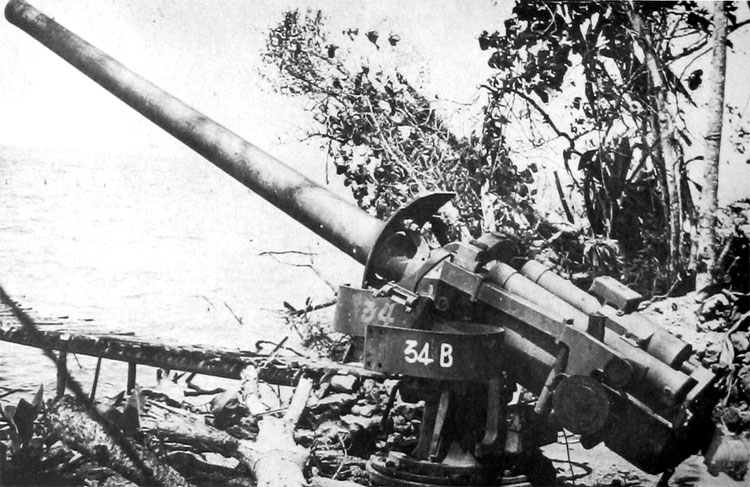
Type 3 140-mm naval gun emplaced at Enogai Inlet, New Georgia, without shield
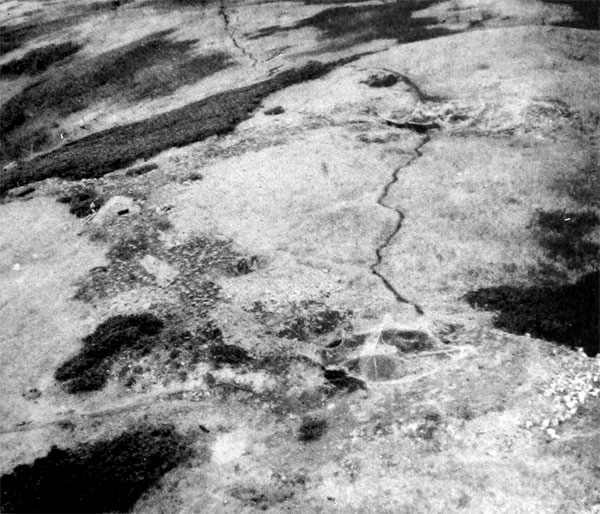
140-mm guns in position at Tamari.

Scale 1:2,555. Noted on the photographs are (A) 140-mm guns, (B) tower,
(C) searchlight.
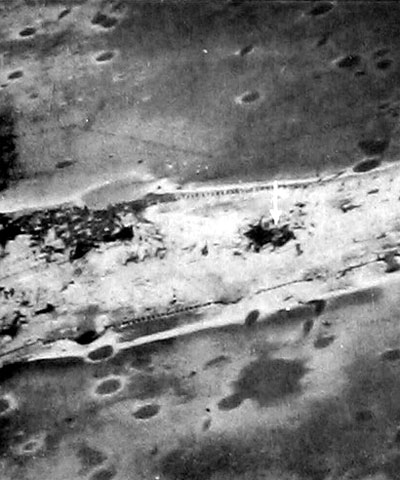
This oblique stereo-pair shows a two-gun 140-mm battery at Tarawa. The observation tower has been destroyed.

Type 3 140-mm gun captured at Saipan,
150-MM 40-CALIBER NAVAL GUN
This gun was manufactured by Armstrong-Whit worth and copied by the Kure Naval Arsenal. It is customarily mounted on ships, but has been captured ashore.
Characteristics
Length of barrel (including breech
mechanism) ... .21 feet (approximately)
Battery layout ... Two, three, or four guns per battery, usually in a straight line or a slight arc, with a centrally located fire control building and range finder.
Revetments ... 26 to 30 feet inner diameter Co crete-covered emplacements 29 feet ?\ 24.5 feet have been captured.
Fire control ... Plotting rooms, 2-meter base finders, and binoculars,
Mount ... Fixed pedestal.
Shield ... Wedge-shaped, approximately 6 feet by 6 feet. Breech projects beyond the shield The top of the shield is inclined sharply at the rear with two small windows in the inclined portion.
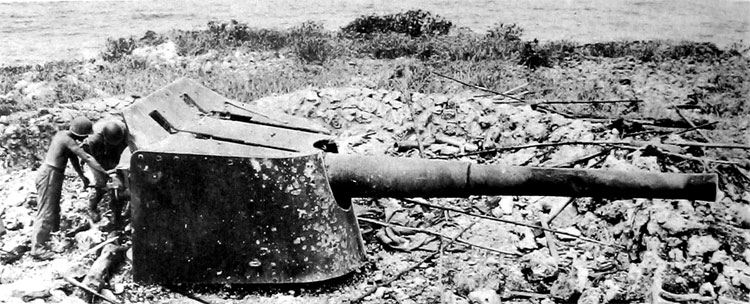
150-mm 40-caliber novel gun in shore emplacement.

Scale 1:4,075. 150-mm 40-cafiber naval guns in coast defense positions on Kiska.

Scale 1:5,756. 150-mm 40-caliber naval guns emplaced on Little Kiska
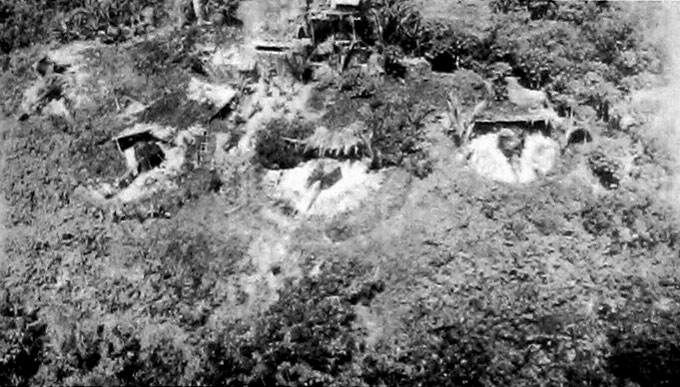
An oblique of 150-mm 40-caliber guns in positlon
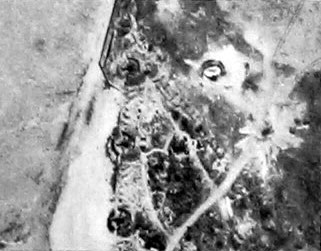
Scale 1:4,000. 150-mm guns at Maloelap Atoll
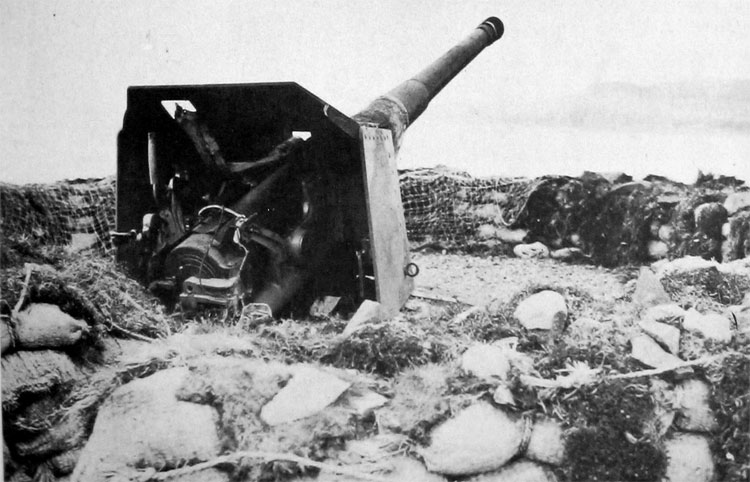
150-mm 40-caliber naval gun captured on Little Kiska,
TYPE 41 (1908) 150-MM 45-CALI8ER NAVAL GUN
This gun resembles the 150-mm 40-caliber gun. Though no shields have been reported yet it is known that on naval vessels it has been fitted with both types of shields used with the 150-mm 40-caliber gun.
Characteristics
Maximum range ... 20,700 yards
Traverse ... 360 degrees
Elevation ... -5 t0 +3° degrees
Mount ... Pedestal.
Shield ... With or without cruiser or naval casemate shield.
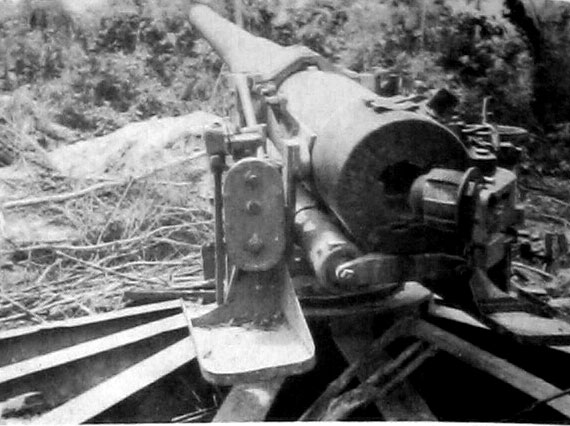
Type 41 150-mm 45-caliber gun partially emplaced at Biak.
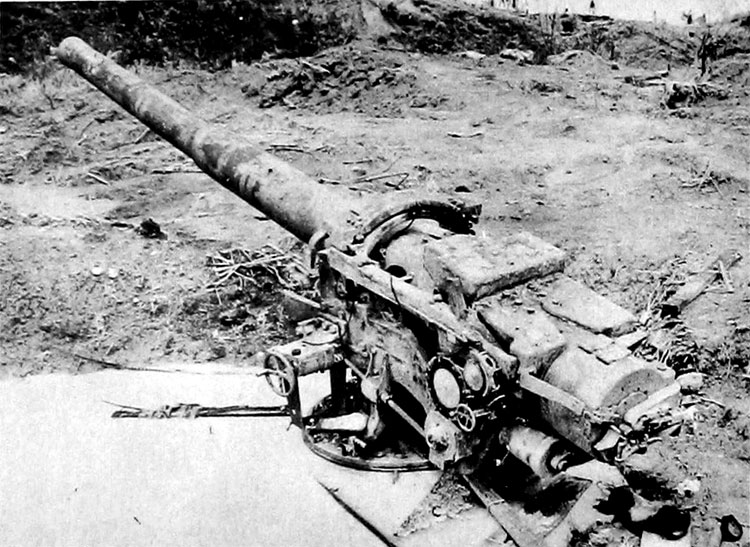
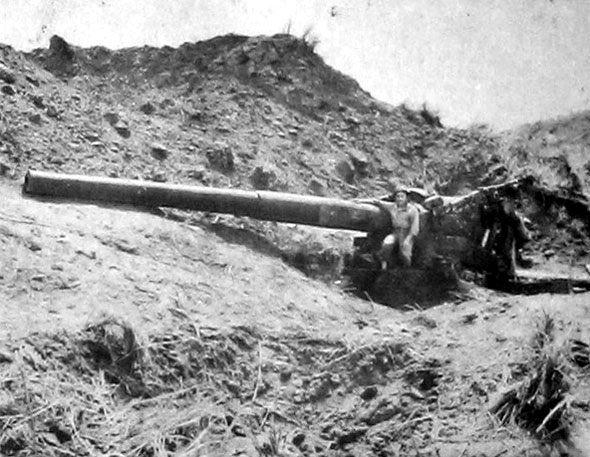
These two photograph show what is believed to be the Type 41 150-mm 50-caliber gun emplaced on Guam.
TYPE 41 (1908) 150-MM 50-CALIBER NAVAL GUN
While the guns shown in the illustrations have not been positively identified as the 150-mm 50-caliber gun, it is believed that they illustrate an improved form of either the 45- or 50-caliber 150-mm guns. On the guns illustrated, counterweights are attached above the tube behind the trunnions.
Characteristics
Length of tube ... 25 feet 10 inches
Maximum range ... 15,800 yards
Traverse ... 360 degrees
Elevation ... -5 to +15 degrees
Battery layout ... Three guns in a battery.
Revetments ... 31 feet inner diameter.
Mount-Pedestal.
Shield—None.
TYPE 3 (T943) 200-MM SHORT NAVAL GUN
This gun was designed for use on merchant vessels for antiaircraft and antisubmarine protection. A similar weapon with a 120-rnm bore is known to have been produced but has not been identified in action. The 200-mm guns captured were used only for coastal defense. The gun has a swinging arm at the left rear for loading.
Specifications
Length of tube ... 6 feet 8 inches
Maximum range ... 6,900 yards (horizontal)
10,750 feet (vertical)
Traverse ... 360 degrees
Elevation ... -15 to +65 degrees
Battery layout ... Usually two guns per battery. They are found around strategic beaches for use in an antiboat role.
Revetments ... Usually concrete, covered emplacements, sometimes open. Rectangular (10 by JO to 15 feet) and circular (12 to 25 feet inner diameter). Emplacements often built into the sides of hills and cliffs.
Fire control ... No external fire control has been identified with this weapon. However, a range finder should be expected.
Mount ... Pedestal, 5-foot diameter at base.
Shield ... None.
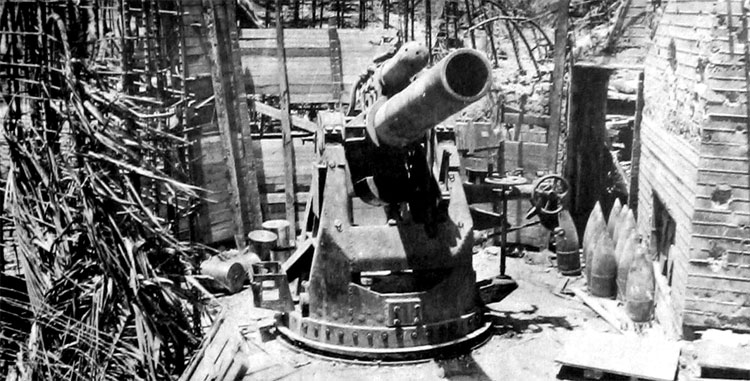
Type 3 (1943) 200-mm gun captured on Guam


Two view of 200-mm gun captured onPeleliu.

Scale 1: 6,650. Four-gun 200-mm gun battery on Iwo Jima.
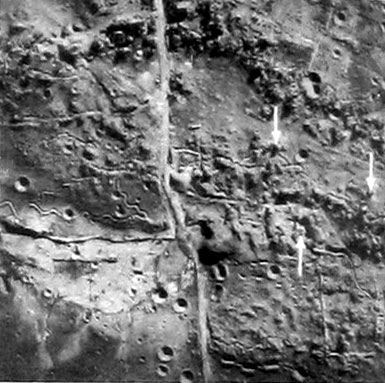
Scale 1: 6,650. This stereo-pair taken on Iwo Jima shows a probable 200-mm gun emplacement under construction and a possible two-gun battery, camouflaged, covering beech and landing area.
200-MM 45-CALIBER GUN
Characteristics
Length of barrel beyond shield ... 19 feet 2 inches
Length of barrel and shield ... 38 feet 10 inches
Battery layout ... Batteries of two guns with an observation tower and a large ammunition building. A small-gauge railroad is used to transport ammunition from the building to the gun.
Revetments ... 37 to 39 feet inner diameter, concrete construction, A 12-inch steel ammunition trough about 2 feet high almost encircles the gun. A ready ammunition building approximately 17 feet by 10 feet
is always located in the rear of the revetment.
Fire control ... Observation tower with range finder and director mounted on one of the lower levels. Mount—Pedestal, placed in concrete or on a
large spade buried in the ground.
Shield ... Shield extends about halfway back along an approximately rectangular platform. It is rounded in front and tapered toward the rear. There is a door on each side and two windows in front. Canvas is stretched over the entire shield and platform giving the impression of a continuous shield.

Photograph of 200-mm gun at Tarawa with canvas cover.

200-mm guns in a tandem emplacement at Tarawa

This oblique photo shows the same installation as the vertical photograph above. The ammunition building has been destroyed by a direct bomb hit.
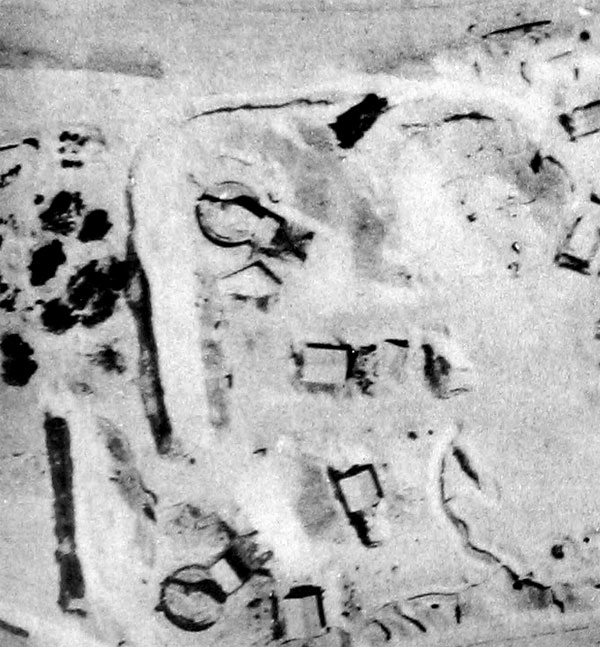
Scale 1:1,555 (approximately). This is a two-gun battery on Wake Island. Note construction of tower for range finder.
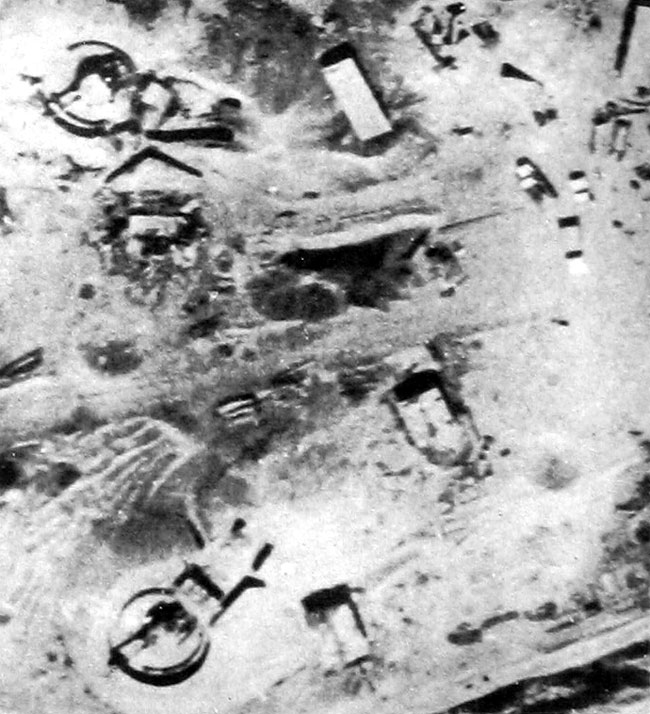
Scale 1:1,760 (approximately). These photographs show that tho range finder has been installed in the new tower.
240-MM 26-CALIBER GUN
This heavy coast defense weapon is reported right of the top carriage elevates the gun. The to have a maximum range of approximately mount is traversed by two men using cranks on 10400 yards. One man at a handwheel at the each side of the chassis at the front.
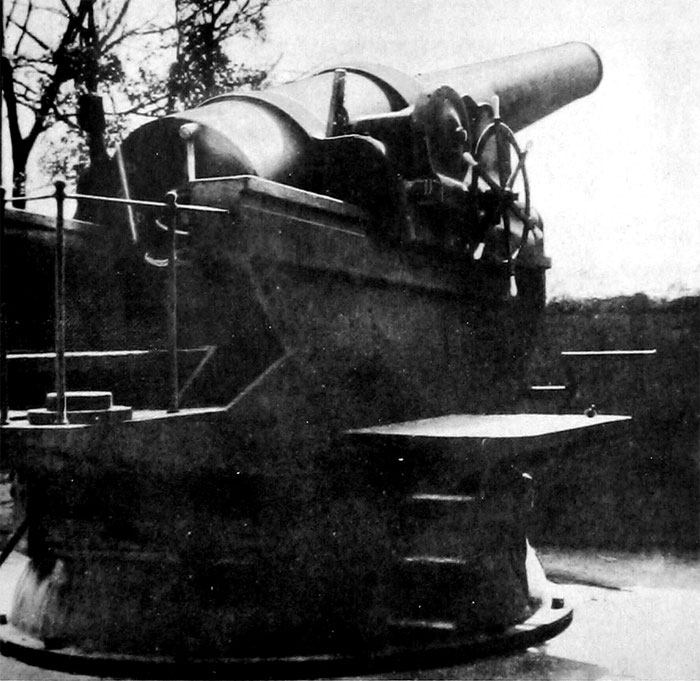
240-mm 26-caliber gun.
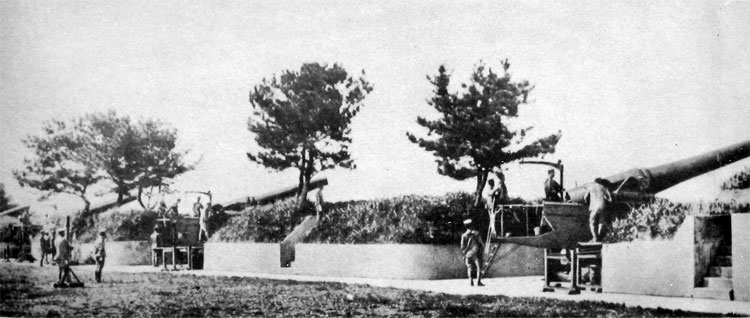
Four-gun 240-mm 26-caliber coast defense battery.
280-MM HOWITZER
This coast defense howitzer has a maximum range of approximately 8,300 yards. The piece can be elevated by two men at handwheels on either side of the front of the top carriage to
more than 65 degrees. The howitzer fires onlv above 45 degrees. The mount is traversed bv men at two cranks on each side of the chassis at the rear.
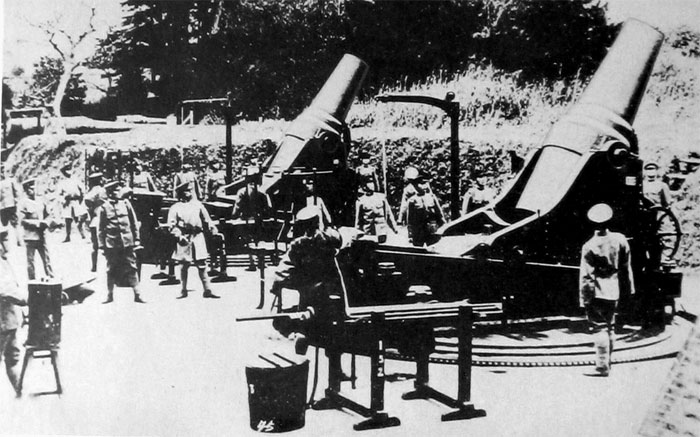
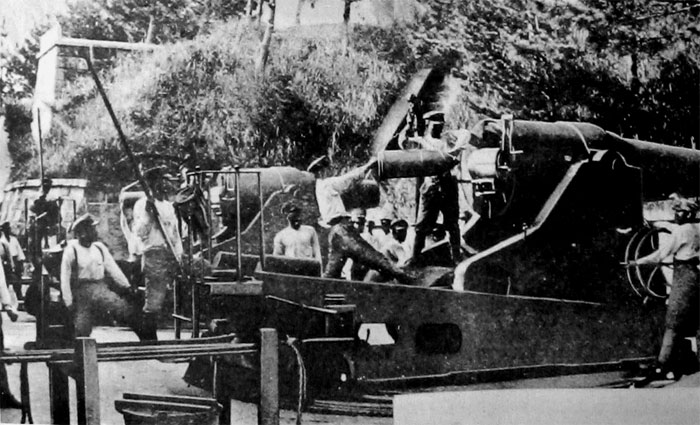
280-mm coast defenie howitzers
SECTION XIV. SEMI-MOBILE HEAVY ARTILLERY AND RAILWAY GUNS
Semi-mobile heavy guns may be mourned in batteries of two or more guns and they are usually easy to detect because of the size of the emplacements or casemates. A considerable
amount of construction activity will be apparent. Railway guns can be fired from semicircular
gun spurs constructed on the main railway line,
or they can be fired from railway turntables
TYPE 45 (1912) 150-MM GUN

The characteristics of this Japanese Army gun are not known. In the photograph above the Type 45 is shown being employed. Note platform struts and rails on which tho cFane travels. The shield is being raised from its transport wogon. The photograph below shows the gun in recoil.
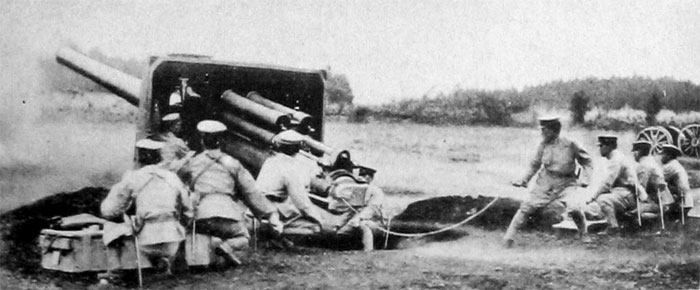
TYPE 45 (1912) 240-MM HOWITZER
It is reported that this piece has a maximum weighing approximately 400 pounds. It is brok range of 11,000 yards, firing a semi-fixed round down and transported on 10 vehicles.
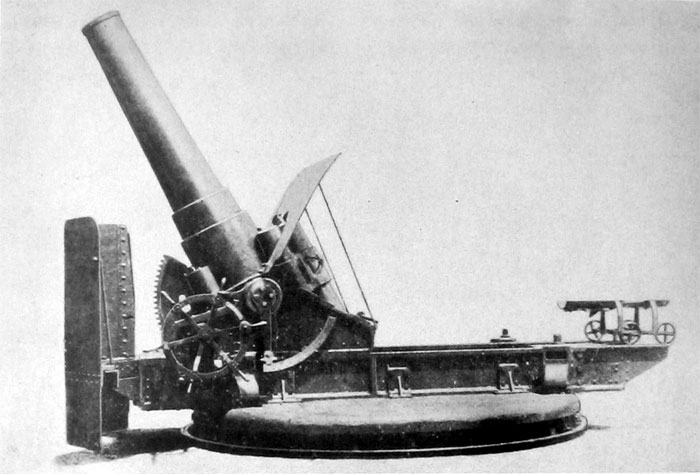
Type 45 (1912) 240-mm howitzer.
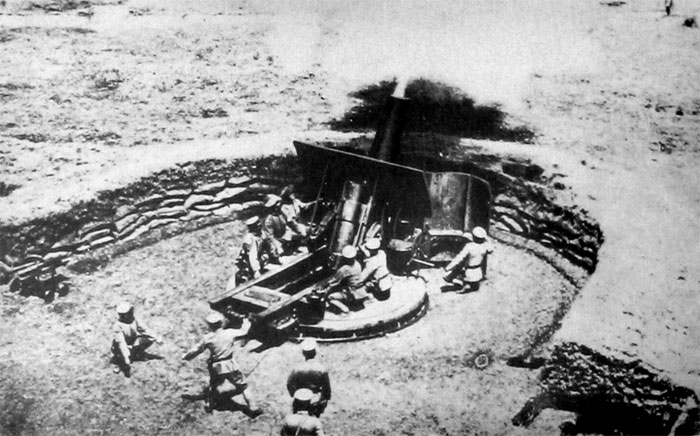
Typo 45 240-mm howitzer In action. Note revetment.
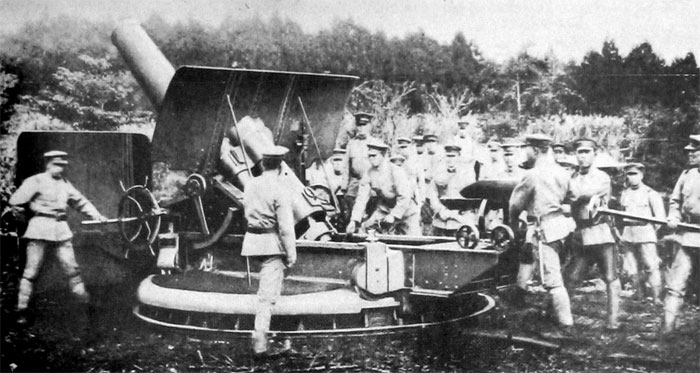
Depressing the tube of the Type 45 240mm howitzer into loading position,

Type 45 240-mm howilzer in action,
MISCELLANEOUS TYPES
The Japanese have bought 170-mm, sio-mm, and 240-mm weapons from Germany, and therefore Japanese copies of these may be expected. In addition, the following heavy artillery pieces
have been reported, but none has been captured Therefore, the characteristics given beJow have not been confirmed.
| Caliber | Type | Length of Bore (inches) | Muzzle Velocity (feet per second) | Range (yards) |
| 240-mm | Type 90 (1930) railway gun | 482 | 3,440 | 54,500 |
| 305-mm | 305-mm Type 7 (1918) short howitzer | 196 | 1,310 | 12,750 |
| 305-mm | Type 7 (1918) long howitzer | 324 | 1,140 | 16,600 |
| 410-mm | Howitzer (siege) | 538 | 1,760 | 21,200 |

240-mm Schneider, railway mount. It is reported that 30 of these railway guns were purchased by the Japanese in 1929.
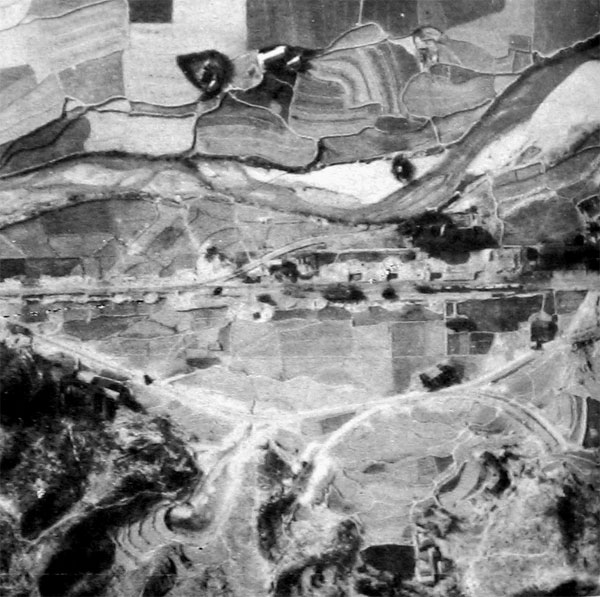
This photo shows dead-end spurs under construction. Two appeare to be covered in an attempt to camouflage whatever type rolling stock may be stabled here. Note the camouflaged railway car on the extreme left side of the photographs and also the antiaircraft positions.

Camouflage with an attempt to hide locomotive.
SECTION XV. VEHICLES
TYPE 99 (1933) SCOUT CAR
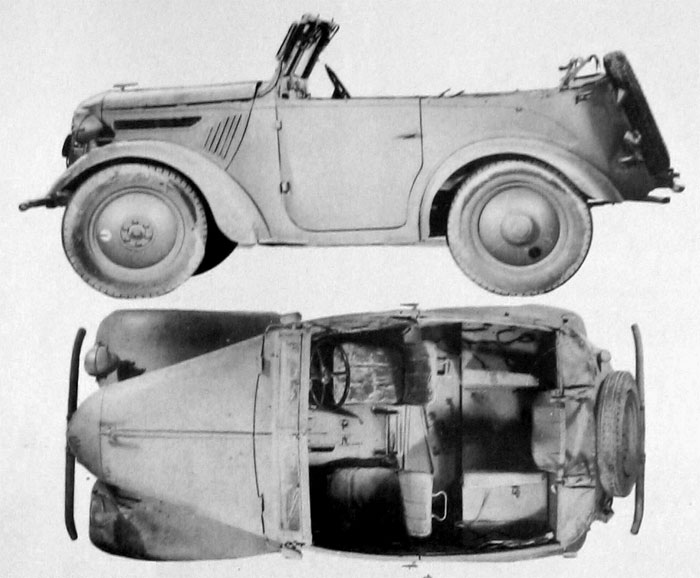
This light-weight, unarmed reconnaissance vehicle was developed following the Manchurian Incident, when ihe need for an all-purpose scout car became pressing. There are four-passenger (shown above) and Iwo-passenger (shown below) body types.
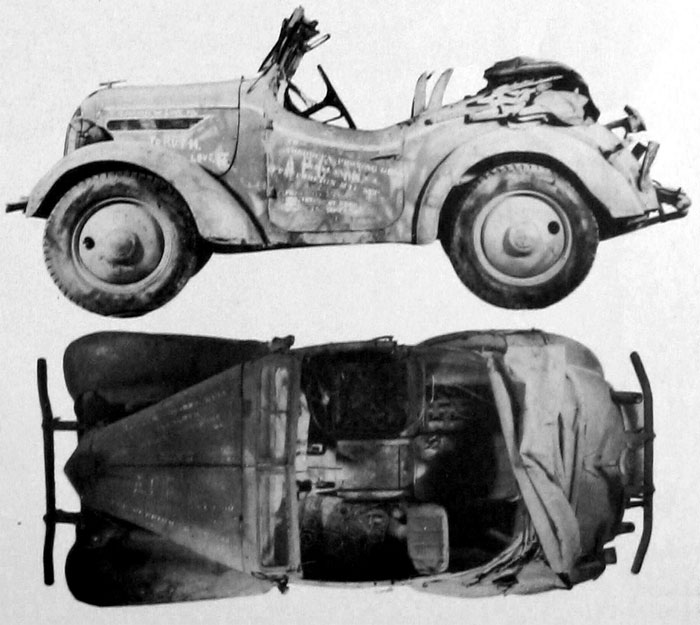
Specifications
Weight ... 2,590 pounds
Length ... 11 feet 4 inches
Width ... 5 feet 2 inches
Height ... 5 feet 3 inches
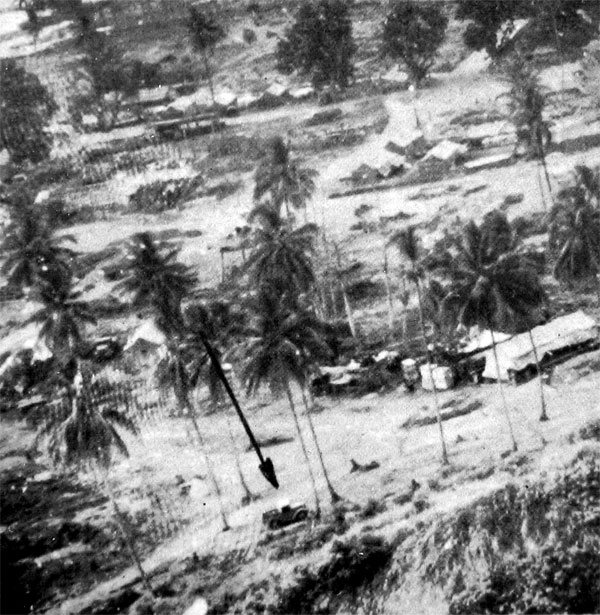
Scale 7 Inches: 100 feet. Scout car made into a light pickup truck, photographed at Rabaut.
STANDARD NISSAN FIVE-PASSENGER SEDAN
This vehicle is used as a passenger staff car.
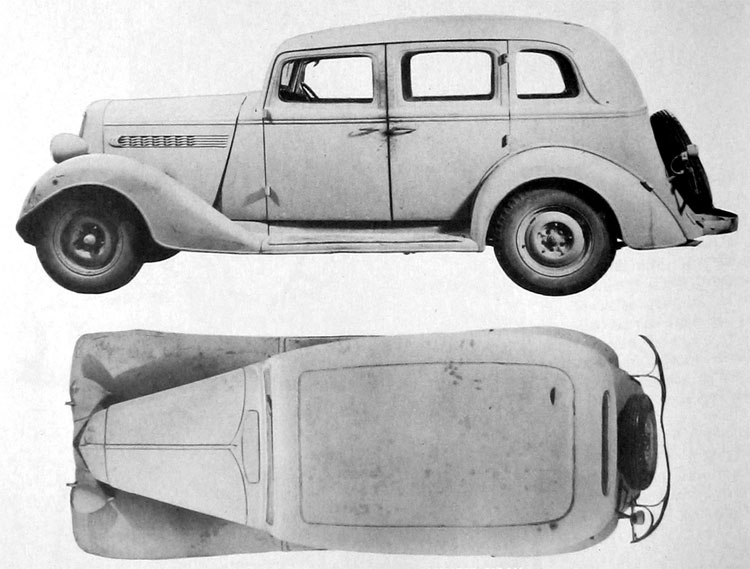
Specifications
Weight ... 3,108 pounds
Length ... 15 feet 6 inches
Width ... 5 feet 7.5 inches
Height ... 5 feet 9 inches
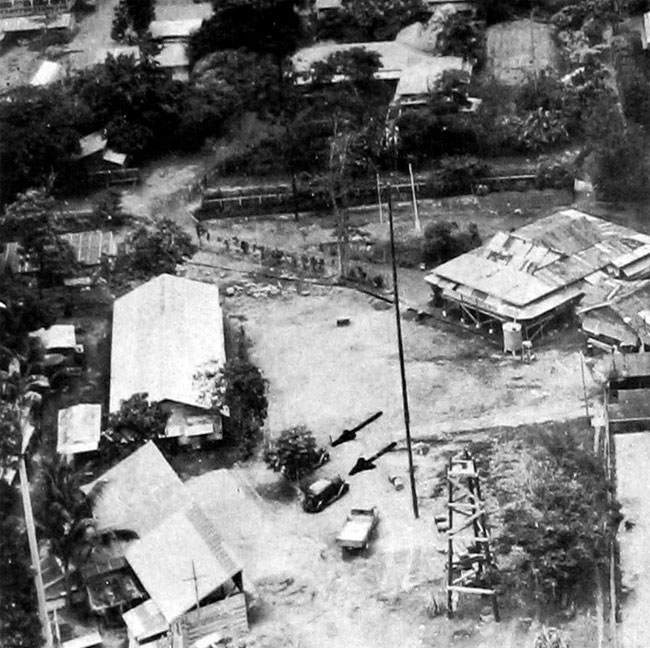
Scale 7 inches: 100 feet. Nissan sedans photographed at Rabaul. (1)
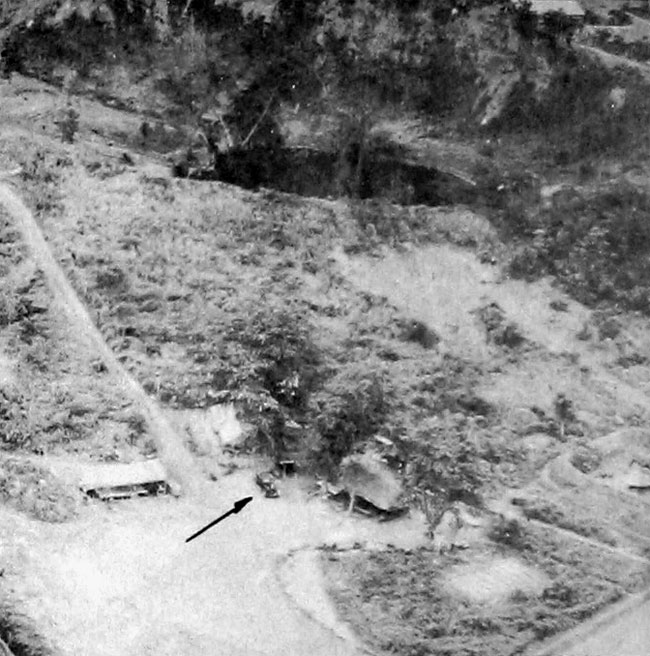
Nissan sedans photographed at Rabaul. (2)
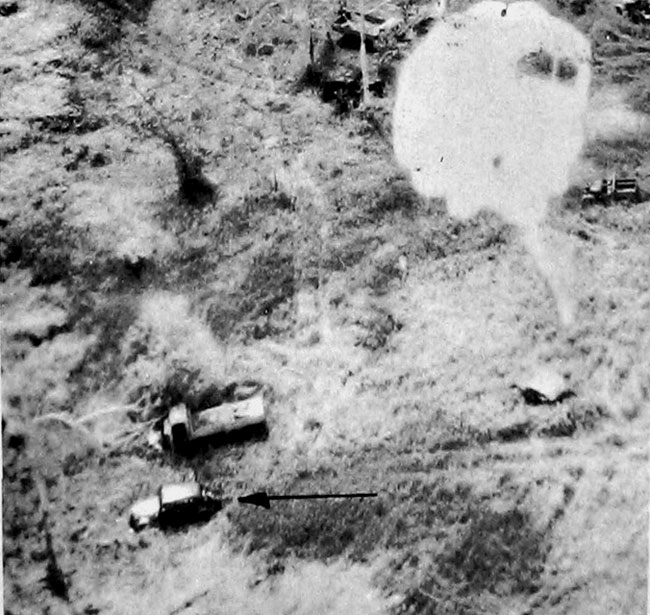
Nissan sedans photographed at Rabaul. (3)
CAB-OVER-ENGINE TRUCK
This truck is used for transport of cargo and personnel. The original model, produced in 1937- was a combination of Graham-Paige and Japanese design.
Specifications
Length ... 14 feet 1.4 inches
Width ... 6 feet 8 inches
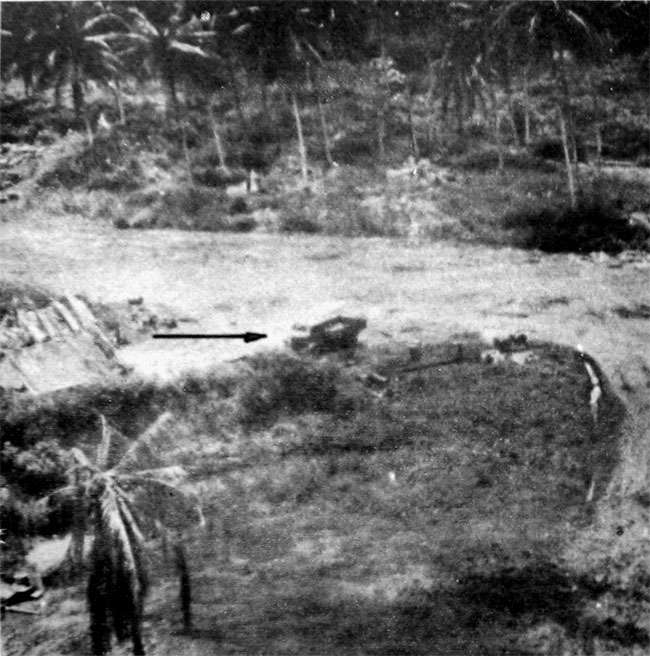
Low altitude oblique.
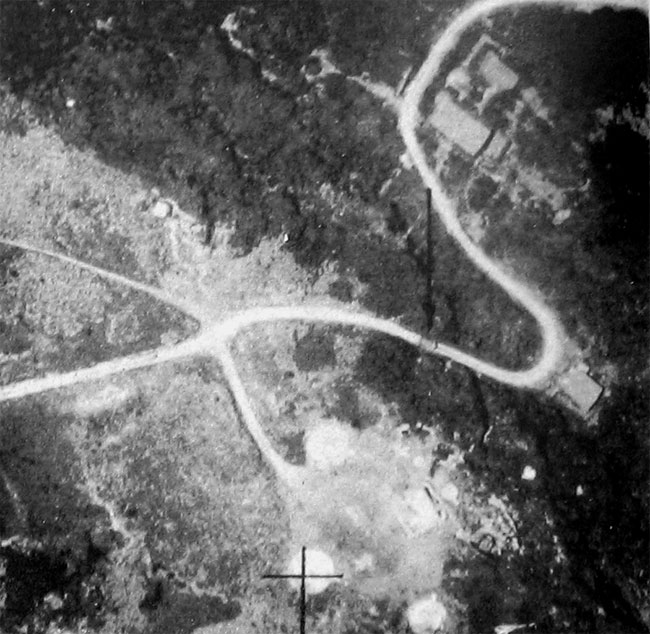
5cale 1:3,755, Japanese truck on Saipan road, believed to be the cab-over-engine
model.
TYPE 1 (1941) TOYODA TRUCK
This model is almost an exact copy of the 1939 Chevrolet truck. It is used as a transport-cargo vehicle. Like other Japanese trucks it may appear with several different body types. Several different truck designs, including American models, are used by the Japanese Army.
Specifications
Weight ... 5,500 pounds
Length .. 18 feet 10 inches
Width ... 6 feet 4 inches
Height ... 7 feet 5 inches

Oblique photographs showing trucks used by the Japanese. (1)
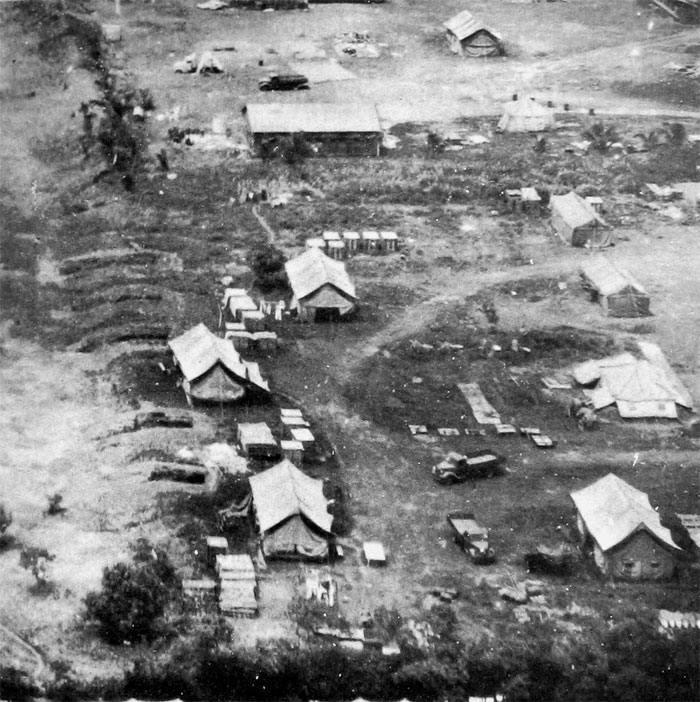
Oblique photographs showing trucks used by the Japanese. (2)
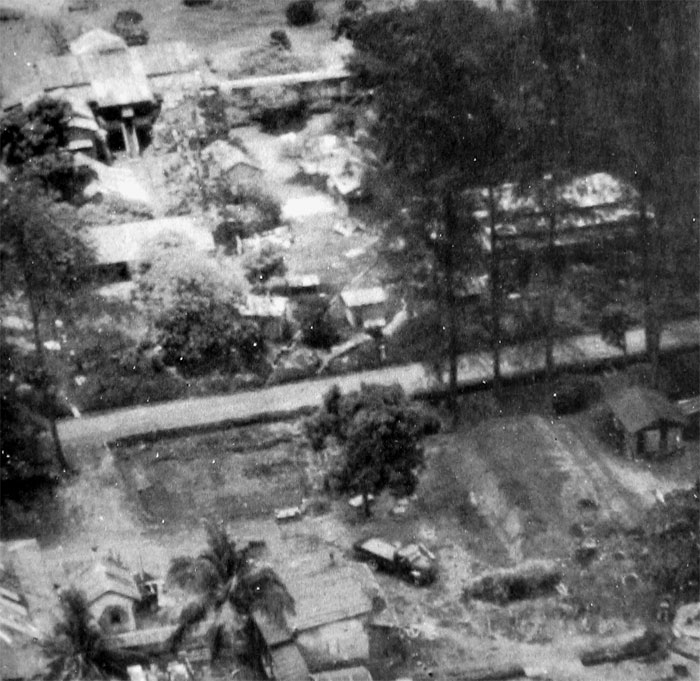
Oblique photographs showing trucks used by the Japanese. (3)
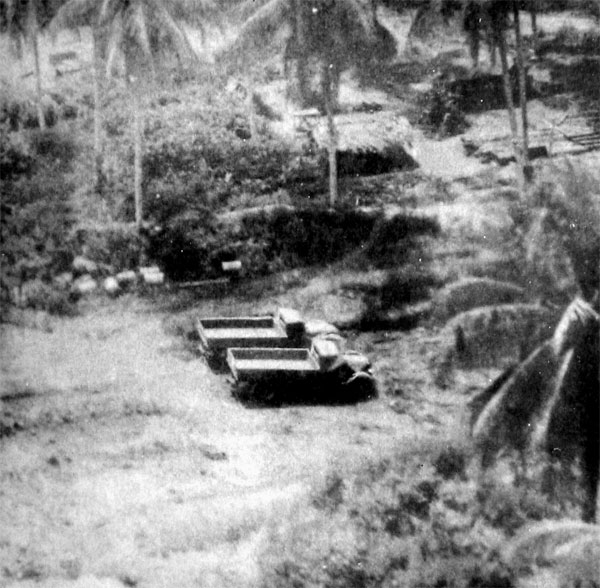
Oblique photographs showing trucks used by the Japanese. All but the vehicle shown top left appear to be Type 1 Toyoda trucks. (1)

Scale 1:3,755, Japanese truck on Saipan.
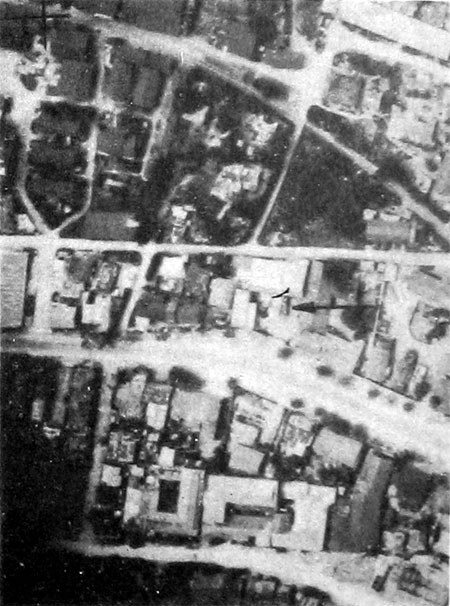
Scale 7:6,650. Trucks parked in dispersal area on Iwo Jima
TYPE 92A (1932) 5-TON PRIME MOVER
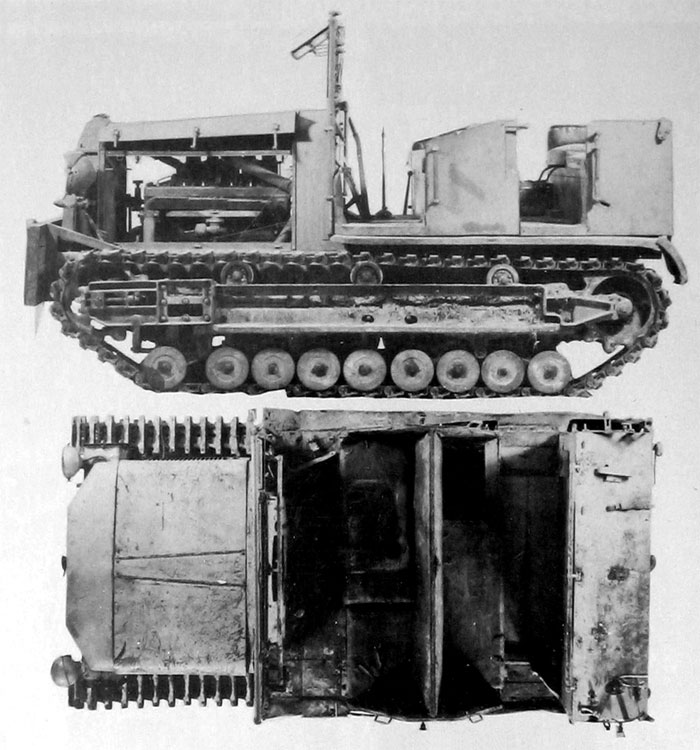
Specifications
Weight ... 5.28 tons
Length ... 11 feet 8 inches
Width ... 5 feet 11 inches
Height ... 7 feet 8 inches
TYPE 98 (1938) 4-TON PRIME MOVER
This vehicle is suitable for the additional roles of reconnaissance vehicle and ammunition carrier. It carries a crew of seven men.
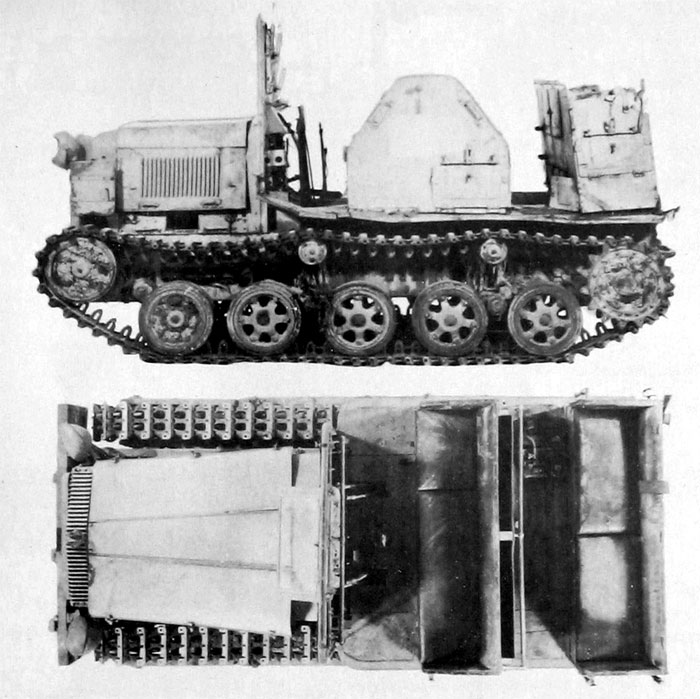
Specifications
Weight ... 4 tons
Length ... 12 feet 5 inches
Width ... 6 feet 1 inch
Height ... 7 feet 3 inches
COMBINATION PRIME MOVER AND WRECKER
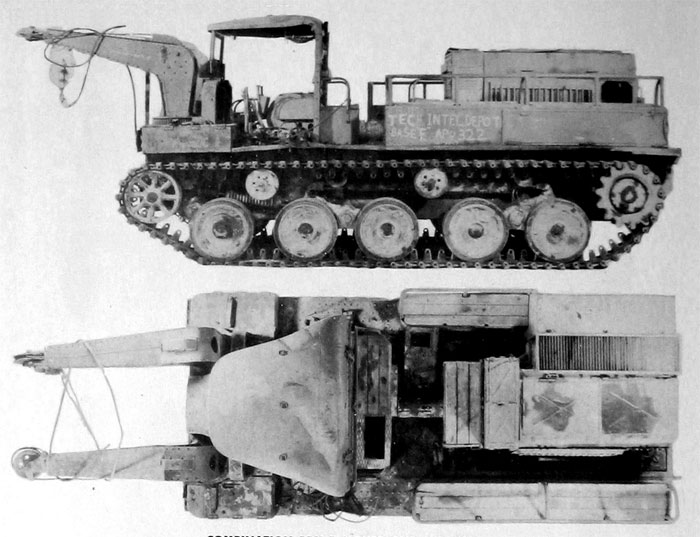
This vehicle, in addition to its function as a prime mover and wrecker, may have been used as a tank-recovery vehicle. The vehicle has total seating space for 13 men- It has two front booms (which may be operated independently), and a removable rear boom (not shown in the photographs).
Specifications
Length (over-all) ... 20 feet S inches
Length (less arms) ... 17 feet
Width ... 7 feet 5.5 inches
Height ... 7 feet 11 inches
TYPE 92 (1932) TANKETTE
The turret of this tankette has been mounted to the rear of the chassis, giving the vehicle a boot-like appearance.
Specifications
Weight ... .3 tons
Length ... 10 feet 3 inches
Width ... 5 feet 3 inches
Height ... 5 feet 4 inches
Crew ... 2 men
Armament ... One machine gun
Performance characteristics
Speed ... 25 miles per hour
Range ... 100 miles
Gradient ... 27 degrees
Trench crossing ... 4 feet 6 inches wide
Step ... 2 feet 1 inch high
Fording ... 2 feet deep
TYPE 94 (1934) TANKETTE
This tankette embodies the general design features of the Type 92, except "that the small rear idler of the Type 92 has been replaced by a large trailing idler.
Specifications
Weight .. 3-4 tons
Length ... 11 feet
Width ... 5 feet 3 inches
Height ... 5 feet 4 inches
Crew ... 2 men
Armament ... One machine
Performance characteristics
Speed ... 26 miles per hour
Range ... 100 miles
Gradient ... 27 to 30 degrees
Trench crossing ... 4 feet 6 inches wide
Fording ... 2 feet deep
TYPE 97 (1937) TANKETTE
Prominent features of this tank are the raised front drive sprocket and the enlarged turret required by the 37-mm gun.


Specifications
Weight ... 4.8 tons
Length ... 12 feet
Width ... 6 feet 4 inches
Height ... 5 feet 11 inches
Crew ... 2 men
Armament ... One 37-mm gun and one
7.7-mm machine gun
Performance characteristics
Speed ... 28 miles per hour
Range ... 100 miles
Gradient ... 30 degrees
Trench crossing ... 5 feet 3 inches wide
Step ... 1 foot 8 inches high
Fording ... 2 feet 6 inches deep
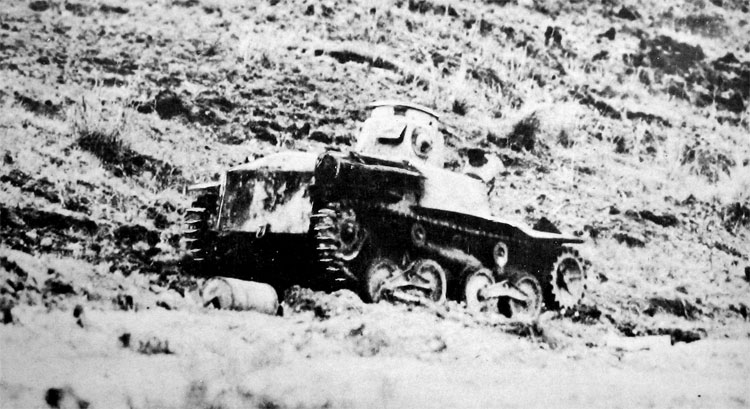
Ground photograph of Type 97 (1937) tanketta.
TYPE 93 (1933) LIGHT TANK
This light tank has a box-type hull with a suspension system including six small bogies on each side and three return rollers. The turret is small, high, and rounded with tapered sides.
Specifications
Weight ... 7.8 tons
Length ... 14 feet 8 inches
Width ... 5 feet 11 inches
Height .... 6 feet
Crew ... 3 men
Armament ... Two machine guns
Performance characteristics
Speed ... 28 miles per hour
Range ... 125 miles
Gradient ... 35 degrees
Trench crossing ... 5 feet 8 inches wide
Step ... 1 foot 6 inches high
Fording ... 2 feet 8 inches deep
Ground photograph of Type 95 (1935) fight tank.
TYPE 95 (1935) LIGHT TANK
This is the Japanese standard light tank. It is a full-track combat vehicle with four large bogies and two return rollers on each side.
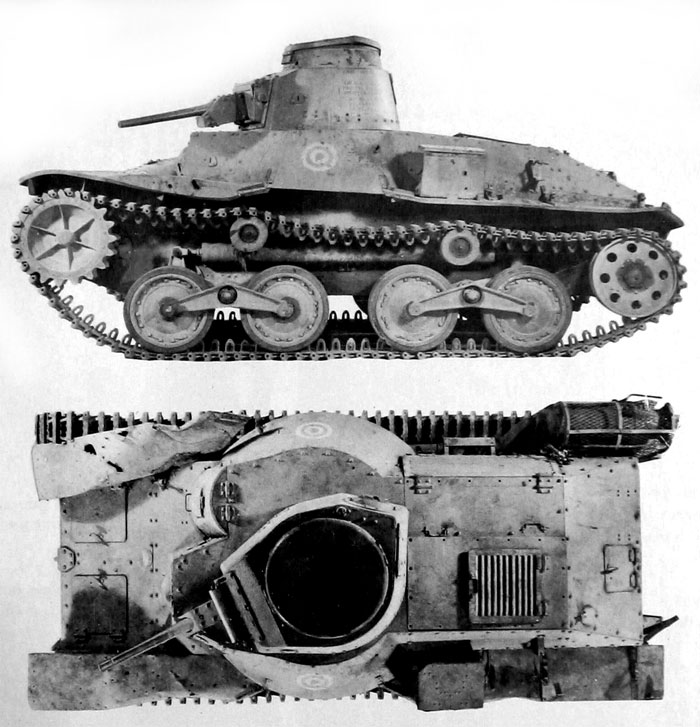
Specifications
Weight ... 8.4 tons
Length ... 14 feet 4,5 inches
Width ... 6 feet 9 inches
Height ... 7 feet 2 inches
Armament ... One 37-mm gun and
two machine guns
Performance characteristics
Speed ... 28 to 30 miles per hour
Range ... 90 to 110 miles
Gradient ... 30 to 45 degrees
Trench crossing ... 6 feet wide
Step ... 2 feet 8 inches high
Fording ... 3 feet 3 inches deep
TYPE 89A (1929) MEDIUM TANK
Identification features of this tank include the Armament One 57-mm gun and box-shaped hull, skirted suspension, nine small two machine guns bodies and five return rollers.
Specifications
Weight ... 13 tons
Length ... 19 feet 3 inches
Width ... 7 feet 1 inches
Height ... 8 feet 6 inches
Crew ... 4 men
Armament ... One 57-mm gun and two machine guns
Performance characteristics
Speed ... 15 miles per hour
Range ... 100 miles
Gradient ... 34 degrees
Trench crossing ... 8 feet 3 inches wide
Step ... 2 feet 9 inches high
Fording ... 3 feet 3 inches deep
TYPE 89B (1929) MEDIUM TANK
This tank is the same as Type 89A except for a longer front plate which is combined with the driver's front plate and the new-type cupola and turret.
Specifications
Weight ... 13 tons
Length ... 19 feet 3 inches
Width ... 7 feet 1 inches
Height ... 8 feet 6 inches
Crew ... 4 men
Armament ... One 57-mm gun and two machine guns
Performance characteristics
Speed ... 15 miles per hour
Range ... 100 miles
Gradient ... 34 degrees
Trench crossing ... 8 feet 3 inches wide
Step ... 2 feet 9 inches high
Fording ... 3 feet 3 inches deep
TYPE 94 (1934) MEDIUM TANK
The skirted suspension system of the Type 94 includes nine small bogies and four return rollers. A ditching tail (shown in the photographs) has been found mounted on these tanks. Type 94 is an arbitrary designation and may be incorrect.

Specifications
Weight 15 tons
Length ... 23 feet (including ditching tail)
Width ... 7 feet 1 inch
Height ... 8 feet 6 inches
Crew 4 men
Armament ... One 57-mm gun and
two machine guns
Performance characteristics
Speed ... 18 to 20 miles per hour
Range ... 100
Gradient ... 34 degrees
Trench crossing ... 9 feet Wide
Step ... 2 feet 9 inches high
Fording ... 2 feet 11 inches deep
TYPE 97 (1937) MEDIUM TANK
This Japanese tank is classed as a medium tank although it fights at about the same weight as the U. S. light tank M5A1. The suspension system includes six large bogies and three return rollers for each side.
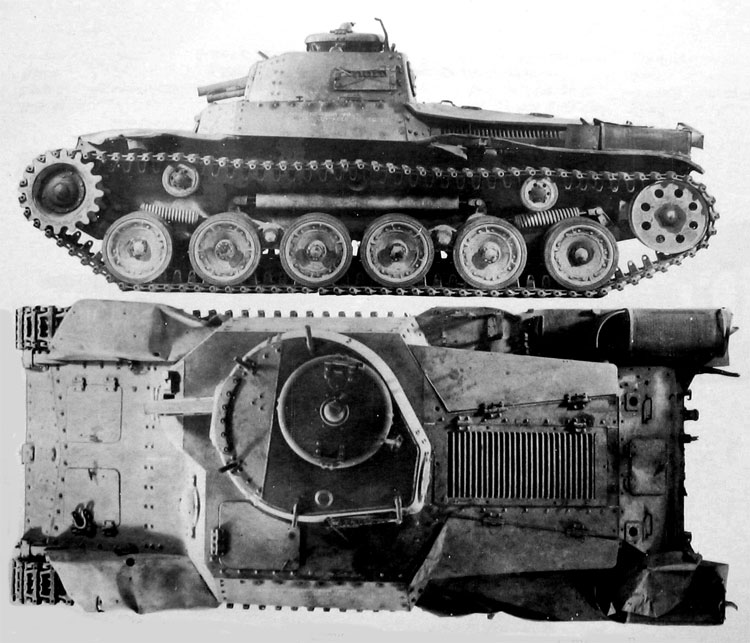
Specifications
Weight ... 14.8 tons
Length ... 18 feet 2 inches
Width ... 7 feet 7 inches
Height ...
7 feet 9.5 inches
Crew 4 men
Armament ... One 57-mm Type 97 gun
and two machine guns
Performance characteristics
Speed ... 25 miles per hour
Range ... 150 miles
Gradient ... 30 to 45 degrees
Trench crossing ... 8 feet 3 inches wide
Step ... 2 feet 6 inches highi
Fording ... 3 feet 3 inches deep
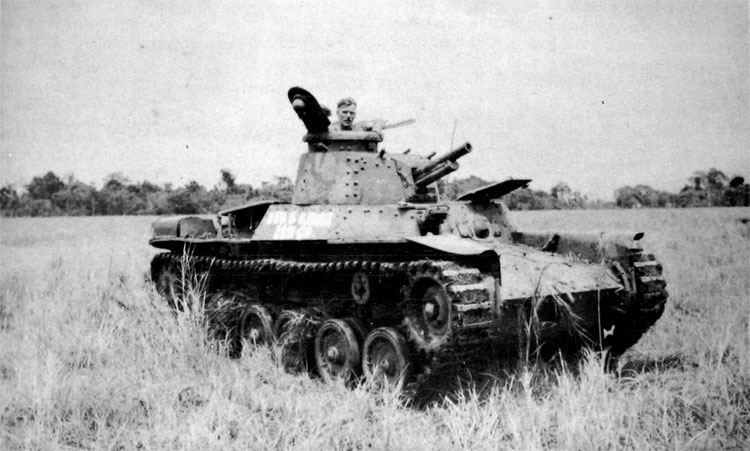
Front view of Type 97 (1937) medium tank.
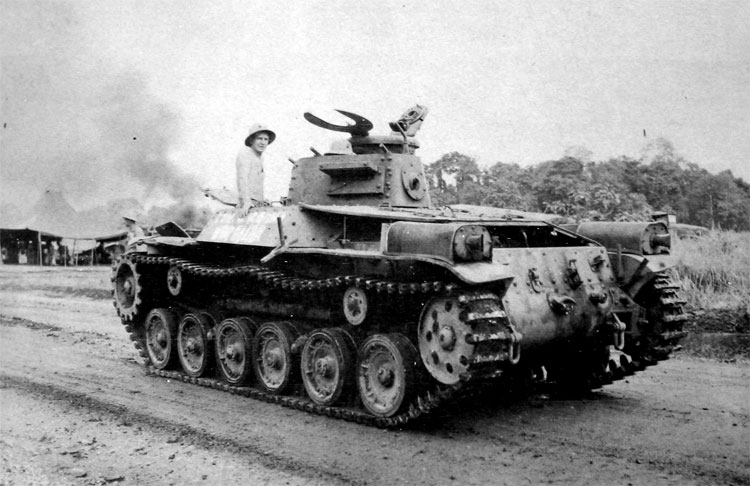
Rear view of Type 97 (1937) medium tank.
TYPE 97 (1937) IMPROVED MEDIUM TANK
This improved model of the Type 97 has a longer turret than the original model to accommodate the 47-mm gun. It has been encountered in considerable numbers.
Specifications
Weight ... 15 tons
Length ... 18 feet 1 inches
Width ... 7 feet 8 inches
Height ...
7 feet 9 inches
Crew 4 or 5 men
Armament ... One 47-mm gun
and two machine guns
Performance characteristics
Speed ... 27 miles per hour
Range ... 100 miles
Gradient ... 34 degrees
Trench crossing ... 8 feet 3 inches wide
Step ... 2 feet 6 inches highi
Fording ... 3 feet 3 inches deep

Captured Type 97 (1937) improved medium tank.
TYPE 2 (1942) AMPHIBIOUS TANK
This vehicle is very maneuverable in water. Its maximum speed afloat is 8 knots. The scale of the vertical view (approximately 1:50) is only half that of other vertical views in this section.
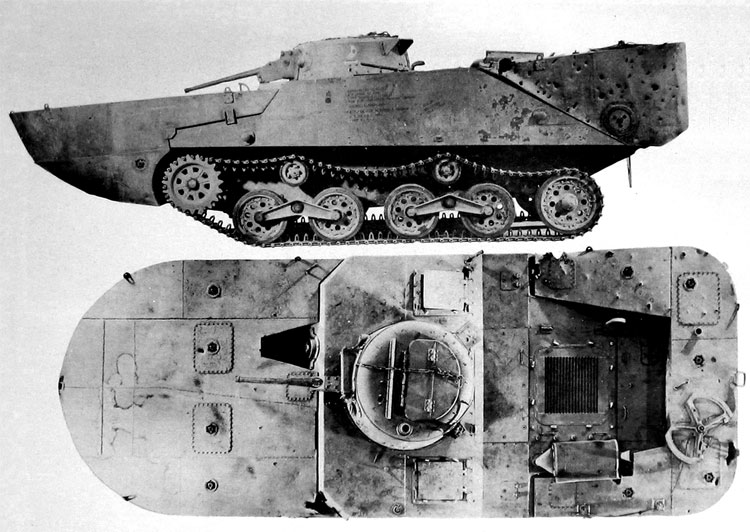
Approximate specifications
Weight ... 12.5 tons (with pontons)
Length ... 24 feet 4 inches (with pontons)
Length without pontons ... 15 feet 10 inches
Width ... 9 feet 2 inches
Height ... 7 feet 8 inches
Crew ... 3 men
Armament ... One 37-mm gun and two
7,7-mm machine guns
Performance characteristics
Speed: On land ... 23 miles per hour.
Afloat ... 6 miles per hour
Range: On land ... 124 miles.
Afloat ... 93 miles
Trench crossing ... 6 feet 7 inches wide
Step ... 2 feet 5 inches high
Approximate specifications
Weight 12.5 tons (with pontons)
Length. ,. 24 feet 4 inches (with pontons) Length without pontons. 15 feet 10 inches
Width 9 feet 2 inches
Height 7 feet 8 inches
Crew 3 men
Armament One 37-mm gun and two
7,7-mm machine guns
Performance characteristics
Speed: On land 23 miles per hour
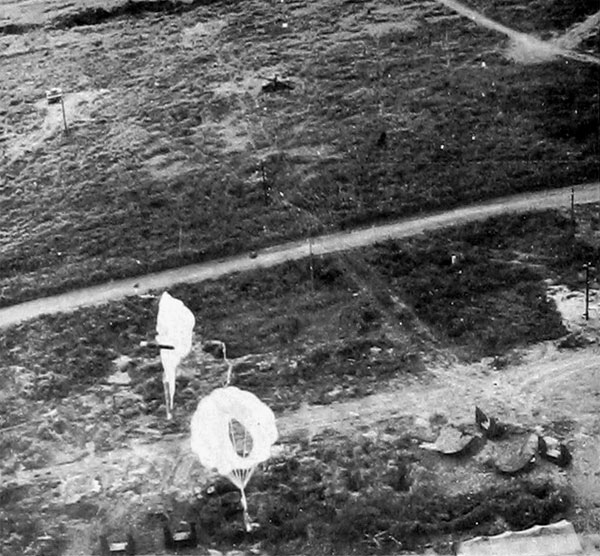
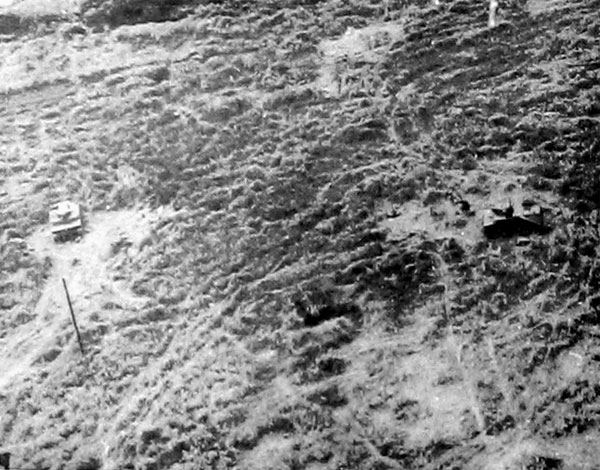
Two amphibious tanks. Note the tracks that lead away from the area where the pontom were dropped. Oblique photograph taken in Rabauf Area.

Partially camouflaged amphibious tank. Japanese gasoline truck
also shown.
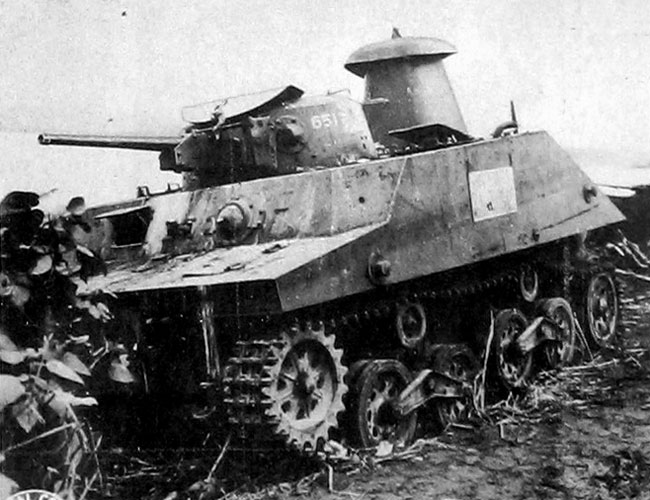
Ground shot of amphibious tank without pontons.
TRUCK-LOCOMOTIVE
This combination truck-locomotive was introduccd by the Japanese in Burma to overcome the severance of rail lines and to replace destrayed locomotives. It has a Diesel engine and will pull up to 10 other vehicles. It resembles a truck in outward appearance and will operate as well on roads as on rails.
Specifications
Length ... 19 feel 2 inches
Width ... 6 feet 5 inches

Ground photograph of truck-locomotive.
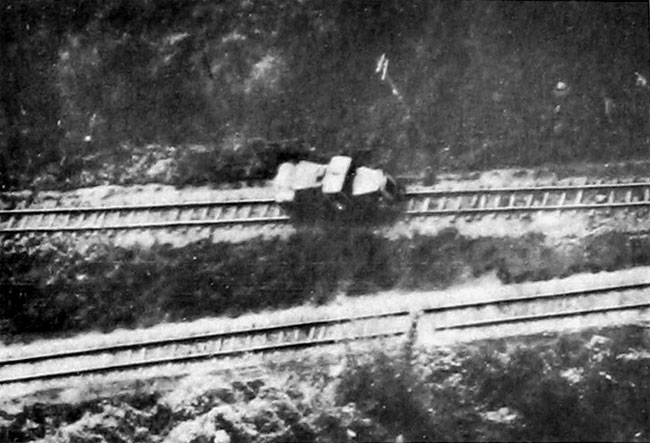
Oblique photograph of truck-locomotive.

Vertical photograph of truck-locomotive. (1)
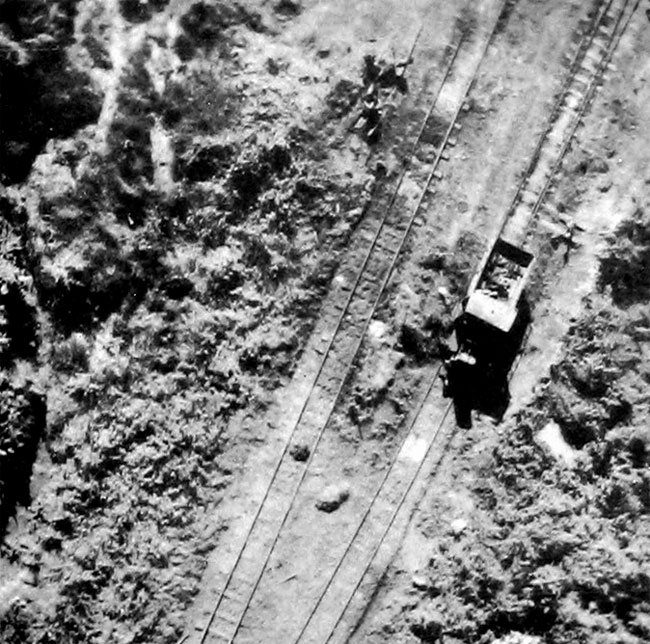
Vertical photograph of truck-locomotive. (1)

Japanese tractor.
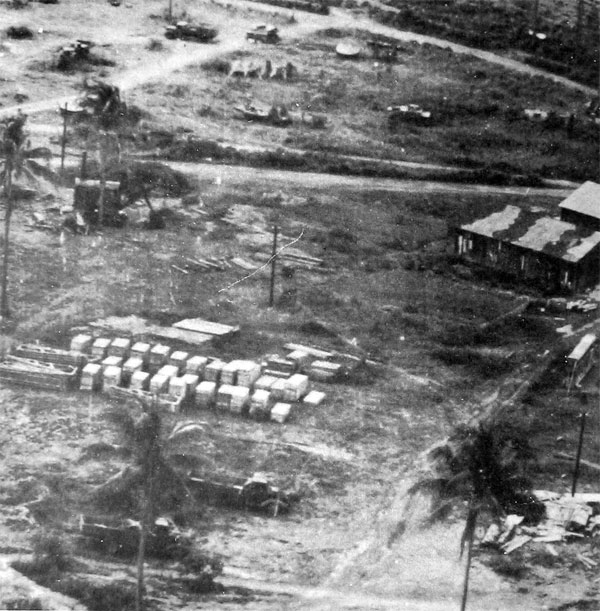
Trucks, amphibious tanks, and steam shovel.
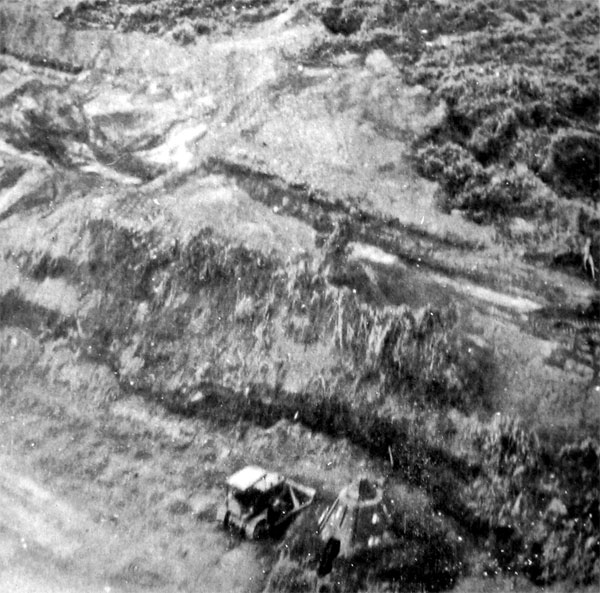
Japanese bulldozer beside steel pillbox.
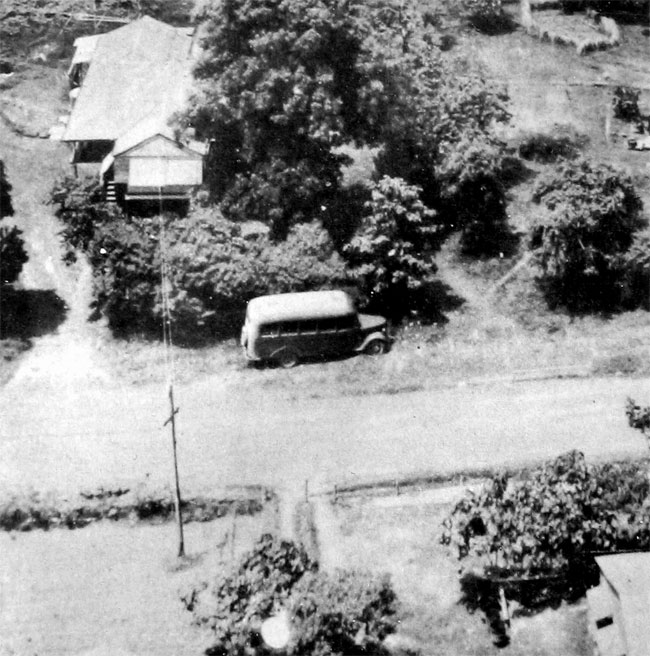
Japanese passenger bus.

Gasoline truck.

Japanese tank.
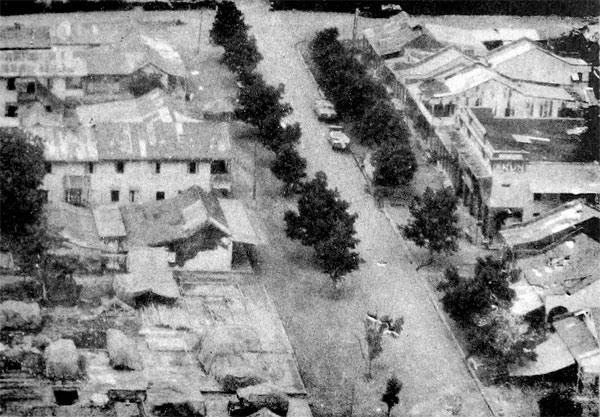
Canvas-covered vehicle; one appears to be cab-over-engine truck.
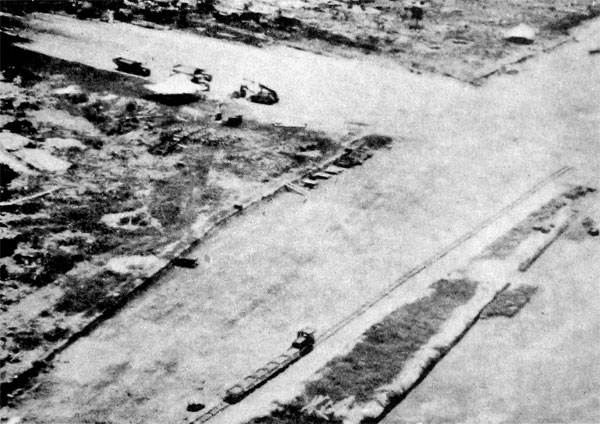
Small railroad engine; trucks and grader in the background
THE END
See also:
PART II. SECTION XI. ARTILLERY. SECTION XII. ANTI-AIRCRAFT ARTILLERY.